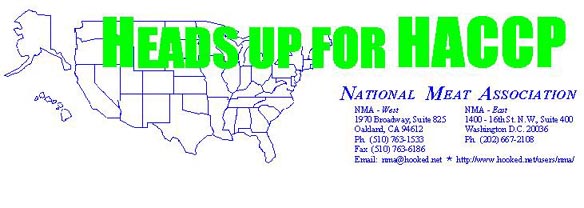

Edited by Jeremy Russell
November 24, 1997
HEADS UP FOR HACCP
BY ROSEMARY MUCKLOW, NMA EXECUTIVE DIRECTOR
There's been a lot of talk, a lot of training, and there's even lots of tension about the importance of HACCP, which begins in large plants on January 26, 1998. NMA asked, even beseeched, FSIS to engage in joint training so that there could be assurance plant personnel and inspectors would read off the same page and come away with the same understanding. Unfortunately, FSIS did not agree.
NMA believes that we have a responsibility to explain HACCP to industry employees and to others that will be affected by the new HACCP system. The purpose this new supplement, HEADS UP FOR HACCP, to our weekly newsletter is to provide straight-forward, practical information which our members can copy and share with their employees. We also hope that grass roots inspectors, especially GS-7s who are not receiving specific HACCP training like higher-rated inspectors, will have access to HEADS UP FOR HACCP and will find the information useful. (The information may be copied for redistribution without specific request or approval from NMA).
NMA is asking a broad group of qualified individuals to contribute their views to this new weekly publication. We also invite any readers to submit their views. We reserve the right to edit material to fit the space constraints. Please send your input to Jeremy Russell, Communications Manager, at NMA by FAX, mail or e-mail.
This first edition will address very basic HACCP concepts. It will take years to implement HACCP and successful implementation will require both application of the scientific principles and a huge change in the roles and attitudes of both inspectors and company workers. HEADS UP FOR HACCP is designed to assist this process.
WHAT IS A CCP?
BY DR. JOE BLAIR, SENIOR VICE PRESIDENT, HACCP CONSULTING GROUP L.L.C.
A simple definition for a "safe" food: You eat it, you don't get sick or injured. That means the right action was taken at the right times to make the food safe. Seem simple? It's not. In fact, it can be a very complex process. The Hazard Analysis and Critical Control Point (HACCP) system is an approach which ensures food safety in a structured and highly organized way so as to create maximum opportunity to take the right actions at the right times. This is where CCPs come into the picture.
The term "CCP" comes from the last 3 letters of HACCP and is an abbreviation for "Critical Control Point." Establishing CCPs is the 2nd of the 7 principles of HACCP. Once you know what areas in production are mostly likely to allow illness or injury to occur from a food, that is once you've located a hazard, you must design the most effective method to control that hazard. You then take planned action to make sure that the control is there and that it works. This planned action is a CCP. The best CCP is the CCP which completely prevents the hazard it was designed to prevent from happening at all. A CCP cannot always do this. So the next best action is to eliminate the hazard. Unfortunately this also cannot always be done. Then the hazard must be reduced to a reasonable or acceptable level of risk.
For example: In the case of canned meat there is the possibility of contamination with a pathogenic bacteria. The best approach for safety is to prevent that contamination from the beginning. There are CCPs which address exactly that. However, in this case, even in the best, most careful commercial operation some contamination is unavoidable. Therefore, a heat treatment in the retort is used as a "kill step." A kill step provides for complete elimination of contamination. It is an important CCP for canned products.
Unlike canned meat, fresh meat cannot provide a kill step within the plant (with the possible exception of irradiation). Since total elimination is not possible, CCPs take other forms. Antimicrobial treatments can effectively reduce bacterial numbers. Timely chilling is important to retard microbial growth.
Determining CCPs is one of the big challenges of HACCP. It is too easy to panic and create more CCPs than necessary. REMEMBER: You want to find the best place to control the hazard. The other extreme is also possible, sometimes it is very difficult to find any CCP within the system. KEEP LOOKING, there are usually some in every meat operation.
Once CCPs are determined, they become the areas with the most intense focus in a HACCP system. A control failure at a CCP should mean that there is a potential food safety hazard in the product. (If this is not the case, then one should question whether this is truly a CCP.) Therefore, evidence of an unsafe food at the plant level means that either an existing CCP was not properly designed and controlled OR that a better CCP is needed.
HACCP plans and their CCPs need to be regularly and systematically reviewed and improved to ensure their effectiveness in producing safe foods.